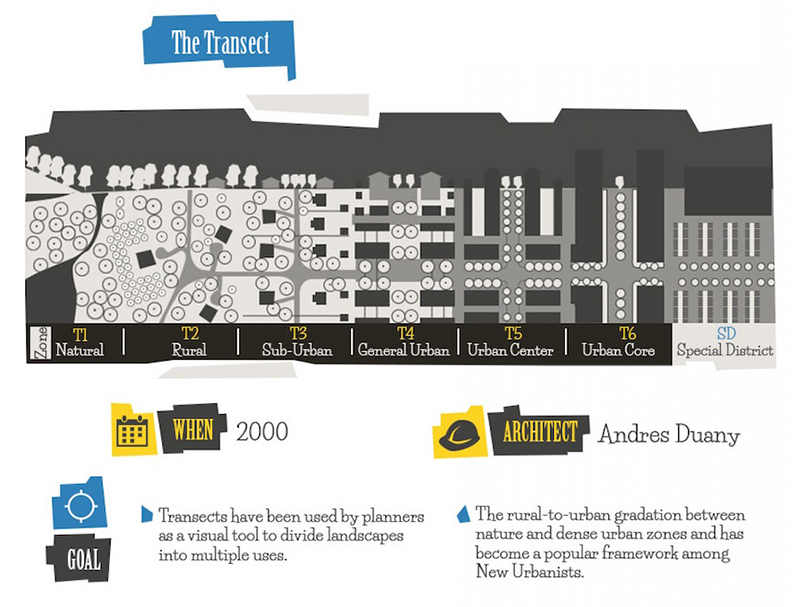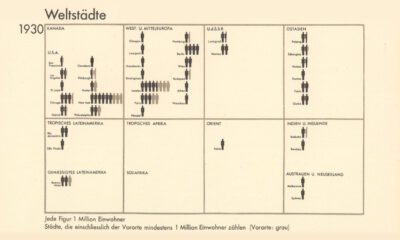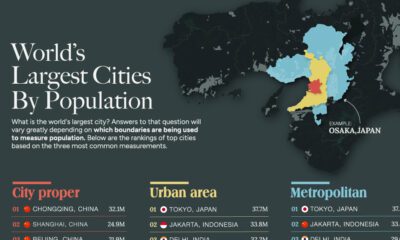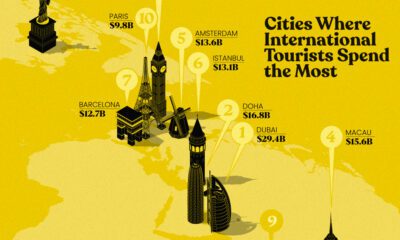Misc
The Evolution of Urban Planning
Urban planning has been around for as long as cities have existed, but the 20th century saw a number of bold ideas that radically changed the make-up of our urban centers.
From garden cities to psychogeography, today’s infographic by Konstantin von der Schulenburg is an informative overview of the modern movements and ideas that shaped urban planning.

The Evolution of Urban Planning
Urban planning has changed a lot over the centuries. Early city layouts revolved around key elements such as prominent buildings (e.g. cathedrals, monuments) and fortification (e.g. city walls, castles).
As cities grew larger, they also became more unpleasant. Here are some key ideas from architects and planners who sought tame the unruly urban beast.
Garden City
At the dawn of the 20th century, cities were experiencing big population growth.
The Garden City concept – devised by the English planner Ebenezer Howard – sought to solve urban overcrowding and poor quality of life by creating smaller, master-planned communities on the outskirts of the larger city. The city would be structured around concentric circles of land use and include a sizeable park and greenbelt. Greenbelts were a revolutionary idea at the time and are still widely appreciated to this day.
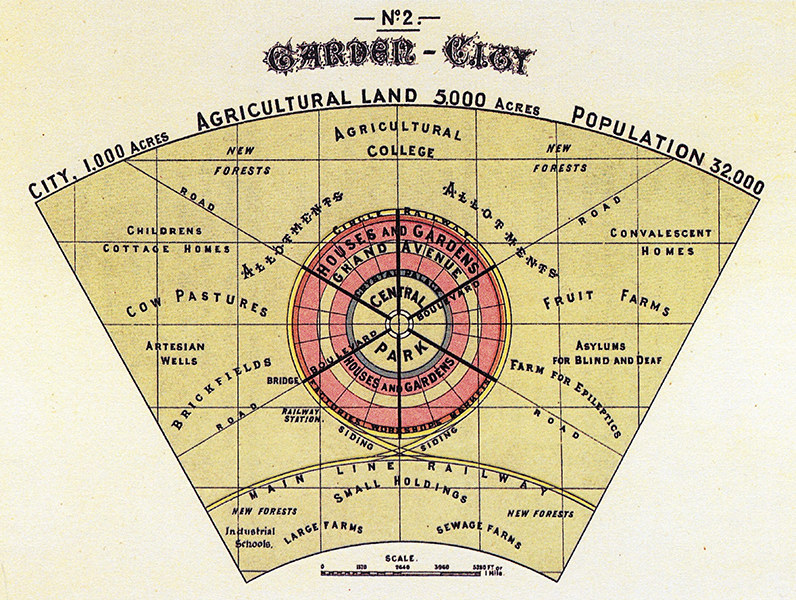
Setback Principle
Early 1900s Manhattan had a population density of nearly 600 people per hectare and the skyscraper boom was in full swing. As buildings grew taller, the already crowded city was becoming a dark and claustrophobic place. To combat this, New York enacted the first citywide zoning code ever in the U.S. to help preserve some daylight on city streets. Setbacks had an immediate and lasting impact on Manhattan’s skyline, as seen today in landmarks such as the Empire State and Chrysler buildings.
Broadacre City
If there is a true antithesis for today’s urbanism, then the suburban brainchild of Frank Lloyd Wright is surely it. Broadacre City was a thought experiment that envisioned decentralized communities that would sprawl across a lush, bucolic landscape. That vision stood in stark contrast to frenetic, exhaust-choked cities of the 1940s, which resembled “fibrous tumor(s)” according to Wright.
Though Broadacre City was never built verbatim, Wright’s rejection of the American city came to life in the form of suburbs and strip malls from sea to shining sea.
La Cité Radieuse
In the wake of World War II, France was searching for solutions to house its population – nearly 20% of all French buildings were either destroyed or seriously damaged – and world renowned architect, Le Corbusier, was one of the architects selected by the French government to construct new, high-density housing.
When La Cité Radieuse (Radiant City) was completed in 1952, it kicked off a media frenzy. Indeed, Le Corbusier is credited with pioneering the Modernist style of architecture that became wildly popular around the world during that time.
While Le Corbusier’s thoughtful residential buildings have stood the test of time, not all projects inspired by the style shared the same fate. For example, when governments in Europe and the United States looked to provide cheap, high-density housing to low income families, the stark tower blocks they built often had the unintentional effect of ghettoizing their inhabitants.
The Megaregion
As cities within close proximity grow and merge together, finding a way to make them work as a connected economic and social unit is a key strategy for becoming more competitive on the global stage.
Jean Gottman, a French geographer, recognized this megaregion trend early on in the Northeast region of the United States. His seminal 1961 study, Megalopolis: The Urbanized Northeastern Seaboard of the United States, outlined the extraordinary dynamics that shaped America’s largest urban corridor.
The Transect
In North America, many cities have a stark divide between urban and suburban areas – a gap known as “the missing middle”. New urbanists seek to create more dense residential development, particularly in walkable, transit-accessible areas.

This new form of city planning isn’t just cosmetic, it may help save cities from bloated infrastructure costs. Recent research into the tax efficiency (property tax revenues vs. infrastructure maintenance costs) of a variety of American cities and found that walkable urban districts tended to be revenue-positive – in effect, subsidizing surrounding low-density areas.
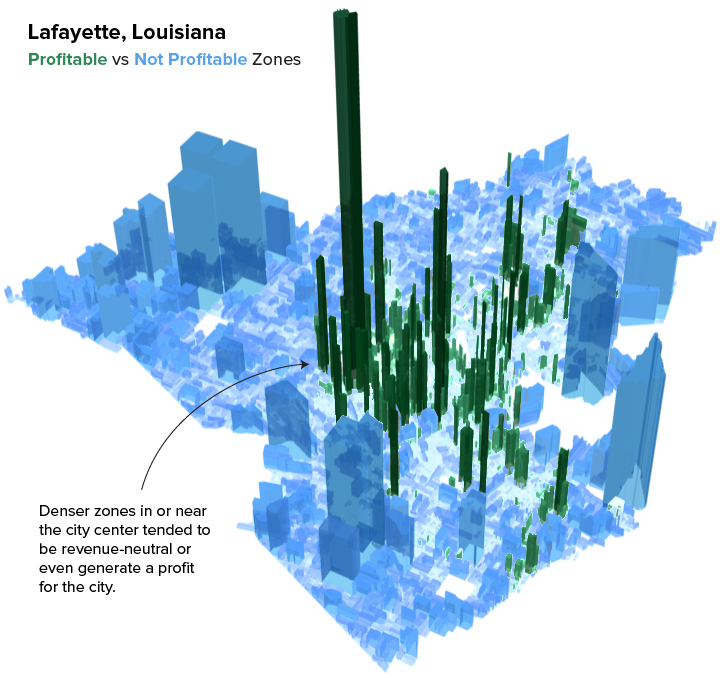
Next Stop: Smart Cities
In the era of big data, the future of our physical spaces may be defined more by bytes than bricks.
City governments have been collecting big picture data for planning in transportation and zoning for some time, but new technology allows for the capture of even more granular data. Cities can now measure everything from noise pollution to wastewater volume, and this can have a big impact on spending efficiency and overall quality of urban spaces.
It’s almost like a FitBit for the city.
– Stuart Cowan, chief scientist, Smart Cities Council
A prominent section of waterfront in Toronto, Canada, is about to become a testing ground for this concept. The partnership between a government agency and Sidewalk Labs, a division of Alphabet, will produce an urban district that fully integrates technology and data collection into its design.
If the project is successful, it may influence the way future “smart” neighborhoods are constructed.
VC+
VC+: Get Our Key Takeaways From the IMF’s World Economic Outlook
A sneak preview of the exclusive VC+ Special Dispatch—your shortcut to understanding IMF’s World Economic Outlook report.

Have you read IMF’s latest World Economic Outlook yet? At a daunting 202 pages, we don’t blame you if it’s still on your to-do list.
But don’t worry, you don’t need to read the whole April release, because we’ve already done the hard work for you.
To save you time and effort, the Visual Capitalist team has compiled a visual analysis of everything you need to know from the report—and our VC+ Special Dispatch is available exclusively to VC+ members. All you need to do is log into the VC+ Archive.
If you’re not already subscribed to VC+, make sure you sign up now to access the full analysis of the IMF report, and more (we release similar deep dives every week).
For now, here’s what VC+ members get to see.
Your Shortcut to Understanding IMF’s World Economic Outlook
With long and short-term growth prospects declining for many countries around the world, this Special Dispatch offers a visual analysis of the key figures and takeaways from the IMF’s report including:
- The global decline in economic growth forecasts
- Real GDP growth and inflation forecasts for major nations in 2024
- When interest rate cuts will happen and interest rate forecasts
- How debt-to-GDP ratios have changed since 2000
- And much more!
Get the Full Breakdown in the Next VC+ Special Dispatch
VC+ members can access the full Special Dispatch by logging into the VC+ Archive, where you can also check out previous releases.
Make sure you join VC+ now to see exclusive charts and the full analysis of key takeaways from IMF’s World Economic Outlook.
Don’t miss out. Become a VC+ member today.
What You Get When You Become a VC+ Member
VC+ is Visual Capitalist’s premium subscription. As a member, you’ll get the following:
- Special Dispatches: Deep dive visual briefings on crucial reports and global trends
- Markets This Month: A snappy summary of the state of the markets and what to look out for
- The Trendline: Weekly curation of the best visualizations from across the globe
- Global Forecast Series: Our flagship annual report that covers everything you need to know related to the economy, markets, geopolitics, and the latest tech trends
- VC+ Archive: Hundreds of previously released VC+ briefings and reports that you’ve been missing out on, all in one dedicated hub
You can get all of the above, and more, by joining VC+ today.
-

 Debt1 week ago
Debt1 week agoHow Debt-to-GDP Ratios Have Changed Since 2000
-

 Markets2 weeks ago
Markets2 weeks agoRanked: The World’s Top Flight Routes, by Revenue
-

 Countries2 weeks ago
Countries2 weeks agoPopulation Projections: The World’s 6 Largest Countries in 2075
-

 Markets2 weeks ago
Markets2 weeks agoThe Top 10 States by Real GDP Growth in 2023
-

 Demographics2 weeks ago
Demographics2 weeks agoThe Smallest Gender Wage Gaps in OECD Countries
-

 United States2 weeks ago
United States2 weeks agoWhere U.S. Inflation Hit the Hardest in March 2024
-

 Green2 weeks ago
Green2 weeks agoTop Countries By Forest Growth Since 2001
-

 United States2 weeks ago
United States2 weeks agoRanked: The Largest U.S. Corporations by Number of Employees

